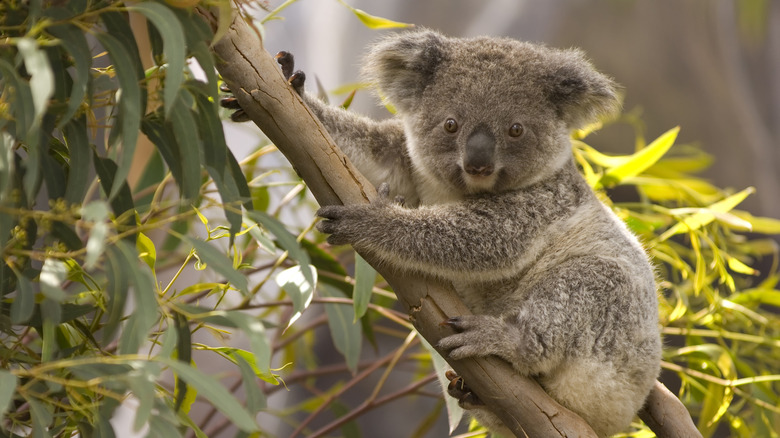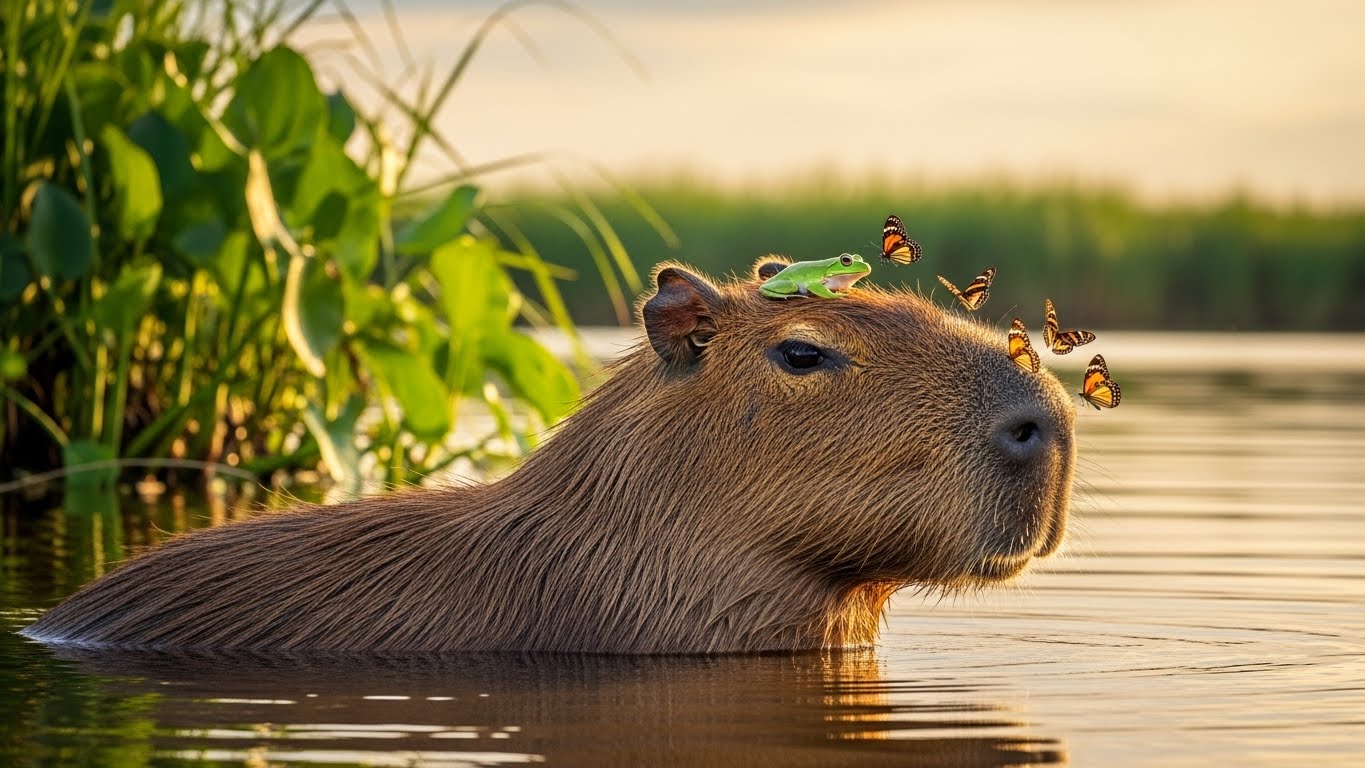Archives
Drop Bear: How a Simple Joke Became an Iconic Tale

Australia is home to many incredible creatures, but none are as infamous—or as fictional—as the drop bear. This mythical beast has captured imaginations and sparked laughter across the globe. From unsuspecting tourists to curious locals, stories of this fearsome koala-like predator have become a rite of passage for anyone venturing down under.
But how did a simple joke about a tree-dwelling terror evolve into an iconic tale? As we delve into the origins and evolution of the drop bear myth, you’ll discover how humor intertwined with folklore creates something truly special. Prepare yourself for an entertaining journey through social media buzz, popular culture references, and even some real-life animal comparisons that will leave you both amused and intrigued by this legendary creature.
Origins and Evolution of the Drop Bear Myth
The drop bear myth is a curious blend of Australian folklore and humor. It originated in the mid-20th century, primarily as a light-hearted way to entertain tourists. Locals began spinning tales of these fierce koala-like creatures that would drop from trees onto unsuspecting victims.
As the story evolved, so did its details. Initially harmless, drop bears transformed into fearsome beasts with sharp teeth and an insatiable hunger for human flesh. The myth became a rite of passage for visitors, often shared around campfires or during bushwalks.
With each retelling, Australians added their unique flair—advice on how to ward off these mythical beasts included slathering Vegemite behind one’s ears or speaking in an Australian accent loudly enough to confuse them. This playful exaggeration kept the legend alive while reinforcing cultural identity among locals.
The Impact of Social Media on the Spread of the Legend
Social media has played a pivotal role in popularizing the drop bear myth. Platforms like Twitter, Facebook, and Instagram have allowed the tale to transcend borders.
Memes featuring this fearsome koala-like creature often circulate widely, capturing attention with humor and absurdity. Users share stories about their encounters with drop bears, blending fact and fiction seamlessly.
Hashtags such as #DropBearChallenge invite playful participation from audiences worldwide. This interactive element brings people together through shared laughter and intrigue.
Moreover, viral videos demonstrating “drop bear” survival tactics showcase creativity while further embedding the legend in digital culture. The blend of storytelling and visual content makes it easy for anyone to engage with the myth.
As social media evolves, so does our relationship with folklore like that of the drop bear. It thrives on these platforms where imagination knows no bounds.
Popular Culture References and Parodies of Drop Bears
The drop bear has found its way into various corners of popular culture, often bringing a humorous twist to the tales. From online memes to quirky merchandise, this fictional creature continues to inspire creativity and laughter.
Television shows have capitalized on the lore as well. Shows like “The Office” and animated series like “Bob’s Burgers” have aired comedic segments referencing drop bears, showcasing how easily one can blend folklore with modern humor.
Social media is another hotspot for drop bear jokes. Countless Instagram posts and Twitter threads playfully warn tourists about these mythical predators lurking in Australian trees. The playful fear they instill adds an entertaining layer to Australia’s wildlife narrative.
Parody videos also thrive around the legend, where creators exaggerate stories or even stage mock documentaries. These light-hearted takes keep the folklore alive while inviting audiences to laugh at their own gullibility regarding such tall tales.
Real Animals vs. Drop Bears: Debunking the Myth
The drop bear, a creature of Australian folklore, has sparked curiosity and fear. Yet, it exists solely in the realm of myth.
In contrast to its fictional counterpart, koalas are gentle and harmless. These adorable marsupials spend their days munching on eucalyptus leaves and sleeping in trees. Their sleepy demeanor offers no threat to unsuspecting tourists.
While myths can be entertaining, it’s crucial to separate fact from fiction. The idea of a predatory koala-like creature that drops from trees is purely imaginative.
This legend likely emerged as a playful way for Australians to tease visitors unfamiliar with local wildlife. It showcases the creativity inherent in storytelling but holds no basis in reality.
Understanding actual Australian fauna can enhance appreciation for the unique ecosystem without falling prey to urban legends like the drop bear tale.
The Role of Humor in Preserving Folklore and Legends
Humor plays a vital role in the preservation of folklore and legends. It allows stories to transcend generations, making them more relatable and memorable. When tales are infused with wit, they become easier to share.
Take the drop bear, for instance. Its absurdity invites laughter while instilling a sense of curiosity about Australian culture. This blend of humor and storytelling captures attention far better than dry facts ever could.
Moreover, humor serves as a coping mechanism. In societies facing challenges or uncertainties, light-hearted tales provide comic relief while reinforcing community bonds. They remind us not to take life too seriously.
As these narratives evolve, their playful nature often makes them malleable—adapting to contemporary contexts without losing their essence. People feel inclined to keep sharing stories that make them laugh; thus, preserving them for future generations enriches cultural heritage through joy and amusement.
Conclusion: The Enduring Legacy of the Drop Bear Story
The drop bear story has woven itself into the fabric of Australian culture. What began as a simple joke evolved into a fascinating tale that sparks both fear and amusement. It showcases how humor can bridge gaps between locals and visitors, creating shared experiences filled with laughter.
Social media played a significant role in amplifying this legend. Online platforms allowed the myth to spread like wildfire, reaching people far beyond Australia’s borders. The blend of horror and hilarity captured attention and curiosity, turning it into an iconic narrative that many love to share.
Drop bears have also made their mark on popular culture through parodies, merchandise, and references in various forms of entertainment. This whimsical creature transcends generations by adapting to contemporary society while maintaining its original charm.
When comparing real animals with drop bears, it’s clear that truth is often stranger than fiction. While there are no ferocious koalas lurking above your head, the fascination surrounding this mythical beast continues to captivate imaginations worldwide.
Humor plays a pivotal role in preserving folklore like the drop bear legend. Through laughter and storytelling, cultural tales remain alive for future generations to enjoy.
This enduring legacy reflects not only Australia’s unique identity but also highlights our universal need for stories—whether grounded in reality or spun from imagination—that unite us all.
Archives
Kibard: The Revolutionary Tool Transforming Digital Workflows

In today’s fast-paced digital landscape, efficiency is key. Businesses are constantly seeking innovative tools to streamline their operations and enhance productivity. Enter Kibard – a revolutionary tool designed to transform how teams manage their workflows. With its intuitive interface and powerful features, Kibard is setting a new standard for digital collaboration. Whether you’re part of a small startup or an established enterprise, this game-changing platform promises to redefine your approach to work. Let’s dive deeper into what makes Kibard stand out in the crowded world of digital workflow solutions.
How Kibard Works
Kibard operates on a user-friendly platform designed to streamline digital workflows. At its core, it integrates seamlessly with existing software tools, allowing teams to manage tasks without the hassle of switching between applications.
Users can create customized dashboards tailored to their specific needs. This flexibility ensures that everyone in an organization remains aligned and informed about ongoing projects.
The tool employs automation features that help reduce manual work. By automating routine tasks, Kibard frees up time for employees to focus on more strategic initiatives.
Collaboration is enhanced through real-time updates and notifications. Teams can communicate directly within the platform, ensuring that information flows smoothly across departments.
Data analytics capabilities provide insights into workflow efficiency. Users can track performance metrics, identify bottlenecks, and make data-driven decisions for improved productivity.
Benefits of Using Kibard in Digital Workflows
Kibard streamlines digital workflows, making tasks simpler and more efficient. Its intuitive interface allows users to navigate seamlessly, reducing the learning curve for teams.
Collaboration is key in any organization. Kibard enhances team communication through real-time updates and shared dashboards. This ensures everyone stays on the same page while working towards common goals.
Additionally, automation features help eliminate repetitive tasks. By automating routine processes, employees can focus their energy on creative problem-solving rather than mundane chores.
Kibard also offers insightful analytics that provide a clearer view of project progress. Teams can track metrics easily and make informed decisions based on data-driven insights.
With its flexibility, Kibard adapts to various industries and needs. Whether it’s marketing or project management, this tool molds itself to fit different workflows effectively.
Success Stories of Companies Using Kibard
Many companies have discovered the transformative power of Kibard in their daily operations. For instance, a mid-sized marketing agency reported a 30% increase in productivity after integrating Kibard into their workflow. Team members found it easier to collaborate on projects and manage deadlines.
In another case, a tech startup streamlined its communication channels using Kibard’s innovative features. They reduced meeting times by half, allowing developers to focus more on coding rather than lengthy discussions.
A leading e-commerce platform also shared impressive results. By automating routine tasks with Kibard, they improved order fulfillment speed significantly, boosting customer satisfaction ratings along the way.
These success stories highlight how diverse industries benefit from adopting this groundbreaking tool. The versatility of Kibard makes it suitable for various business models and sizes alike. This adaptability is key to its growing popularity among forward-thinking organizations.
Comparison to Other Digital Workflow Tools
Kibard stands out in a crowded market of digital workflow tools. While many platforms offer task management and collaboration features, Kibard integrates these functions seamlessly with automation capabilities.
Unlike traditional tools that require manual input for recurring tasks, Kibard automates processes, saving time and reducing human error. Users can set triggers and actions that operate independently once configured.
Many competitors focus solely on project tracking or communication. In contrast, Kibard combines both elements into one cohesive system. This holistic approach enhances team productivity by minimizing the need to switch between different applications.
Additionally, while some platforms come with steep learning curves, Kibard prioritizes user experience. Its intuitive interface allows teams to adapt quickly without extensive training or onboarding sessions.
For businesses looking to improve efficiency, understanding these unique aspects makes Kibard a powerful choice among various digital workflow solutions available today.
Future Developments for Kibard
Kibard is on the cusp of exciting innovations. The development team is actively exploring ways to enhance user experience through AI-driven automation features.
Upcoming updates are set to integrate advanced analytics, providing users with deeper insights into their workflows. This will empower teams to make data-informed decisions swiftly.
Additionally, Kibard plans to streamline collaboration tools. Enhanced real-time communication features could facilitate seamless teamwork across different platforms and time zones.
There’s also talk of customizable integrations with popular software in various industries. This flexibility would allow companies to tailor Kibard functionalities according to their unique needs.
Enhanced security protocols are a priority. As digital workflows grow more complex, ensuring user data remains protected is essential for maintaining trust and reliability within the platform.
Conclusion
Kibard is reshaping the landscape of digital workflows. With its innovative features and user-friendly interface, it stands out among traditional tools. The ability to integrate seamlessly into existing processes makes it an attractive choice for businesses looking to increase efficiency.
As organizations continue to embrace remote work and collaboration, Kibard’s role becomes even more essential. Its adaptability means that companies can tailor their workflows according to specific needs, driving productivity like never before.
With success stories from various industries highlighting significant improvements in team performance and communication, it’s clear that Kibard is not just another tool; it’s a game-changer. As more companies discover its potential, the demand for such an intuitive solution will only grow.
Looking ahead, there are exciting developments on the horizon for Kibard. Continuous updates promise enhanced features that will keep users engaged while addressing evolving market demands.
For anyone seeking a way to streamline digital workflows effectively, exploring what Kibard has to offer might be a worthwhile investment in your business’s future.
Archives
Cadibara: Nature’s Most Sociable Rodent

Have you ever heard of the cadibara? This remarkable creature, often dubbed nature’s most sociable rodent, is a fascinating blend of charm and charisma. With its unmistakable features and friendly demeanor, the cadibara has captured the hearts of many around the globe. From lush wetlands to riversides, these gentle giants thrive in their natural habitats while exhibiting some truly intriguing social behaviors. Whether you’re a wildlife enthusiast or simply curious about this unique animal, there’s so much more to discover about the cadibara and its captivating world!
Physical Characteristics of the Cadibara
The cadibara, or capybara, is the largest rodent in the world. Weighing between 77 to 150 pounds, they have a robust and barrel-shaped body.
Their fur is coarse and short, typically ranging from reddish-brown to grayish tones. This unique coat helps them blend into their natural surroundings.
Cadibaras possess webbed feet that make them excellent swimmers. Their strong limbs aid in both swimming and running on land.
One of their most distinctive features is their large eyes positioned high on their heads. This adaptation allows them to keep watch for predators while mostly submerged in water.
With a broad snout and prominent front teeth, these rodents are perfectly equipped for grazing on aquatic plants and grasses. Their physical traits not only enhance survival but also contribute to their charming appearance.
Habitat and Distribution
Cadibaras thrive in diverse environments, primarily found in South America. They inhabit regions near bodies of water, including rivers, lakes, and wetlands. These areas provide not only hydration but also ample food sources.
Their range stretches across countries like Brazil, Venezuela, Colombia, and Argentina. The warm climate suits them well while lush vegetation offers shelter from predators.
Cadibaras prefer grasslands and swamps where they can graze on aquatic plants. Their adaptability allows them to flourish in both wild habitats and man-made surroundings such as farmland or parks.
This versatility makes cadibaras a common sight in many ecosystems across their native continent. Their affinity for wetland areas plays a crucial role in maintaining the ecological balance within these regions.
Diet and Eating Habits
The cadibara’s diet primarily consists of grasses and aquatic plants. These herbivorous rodents have an impressive ability to consume large quantities of vegetation daily.
In addition to grass, they enjoy fruits, vegetables, and even bark from trees. Their teeth are specially designed for grinding down tough plant material. This adaptation allows them to thrive in various environments.
Cadibaras often feed at dawn or dusk when temperatures are cooler. They tend to stay close to water sources while eating since their diets can be high in moisture content.
Interestingly, they practice coprophagy—eating their own feces—to extract maximum nutrients from their food. This unique behavior ensures that they’re getting the most out of what they eat while maintaining a healthy digestive system.
Their grazing habits not only sustain them but also play a vital role in shaping their ecosystem by promoting plant growth and diversity around waterways.
Social Behavior of Cadibaras
Cadibaras are known for their extraordinary social behavior. They thrive in groups, often seen lounging together or grazing peacefully. This sociable nature is essential for their survival.
Within these groups, a clear hierarchy exists. There are dominant members who lead and protect the others. The bonds between cadibaras are strong; they groom each other to reinforce friendships and reduce tension.
Communication plays a vital role in their interactions. Cadibaras use various vocalizations to express emotions or alert others of potential dangers. These sounds range from soft whistles to loud barks.
Their cooperative spirit extends beyond mere companionship. When it comes time to find food or evade predators, working together increases their chances of survival significantly.
This communal lifestyle not only supports individual safety but also strengthens group dynamics, making cadibaras one of nature’s most fascinating rodents.
Benefits of Living in a Group
Living in groups offers cadibaras numerous advantages. Safety is a primary benefit. When they’re together, the chances of spotting predators increase dramatically. This collective vigilance helps keep individual members out of harm’s way.
Social interaction enriches their lives too. Group dynamics promote bonding and friendly play among young cadibaras, fostering strong relationships that last a lifetime.
Another advantage is resource sharing. In larger groups, food sources can be located more efficiently. They often work as a team to graze on grasses and aquatic plants, ensuring everyone gets enough to eat.
Moreover, group living allows for better parental care. Adults look after each other’s young while others forage or relax nearby. This cooperative behavior enhances survival rates for the next generation.
These traits make the social structure of cadibaras fascinating to observe and study in nature’s grand design.
Interaction with Humans
Cadibaras are known for their friendly and approachable nature, often captivating those who encounter them. In many regions, people thrive on the opportunity to observe these gentle giants in their natural habitat.
Farmers sometimes appreciate cadibaras as they help maintain lush vegetation near water sources. Their grazing habits can control invasive plant species, promoting a balanced ecosystem.
However, there is a flip side to this interaction. As human populations expand into cadibara territories, conflicts may arise. Farmers occasionally view them as pests due to crop damage.
Despite potential challenges, many communities celebrate these rodents by organizing eco-tours or wildlife education programs. This fosters respect and understanding of the cadibara’s vital role in local ecosystems.
The bond between humans and cadibaras highlights the importance of coexistence with nature. Engaging with these creatures offers a unique glimpse into wildlife dynamics that enrich our shared environment.
Conservation Efforts for the Cadibara
Conservation efforts for the cadibara are crucial as their populations face various threats. Habitat destruction, primarily due to agricultural expansion and urbanization, poses a significant risk to these social rodents.
Organizations dedicated to wildlife protection are actively working towards preserving cadibara habitats. They establish protected areas that allow these creatures to thrive in their natural environment.
Community education programs also play a vital role. Teaching locals about the ecological importance of cadibaras helps foster coexistence and reduces human-wildlife conflict.
Research initiatives focus on studying cadibara behavior and ecology. This knowledge aids in creating effective conservation strategies tailored to their needs and challenges they face.
Collaborations between governments, NGOs, and local communities enhance these efforts. Together, they aim to ensure that future generations can enjoy the sight of these charming animals in the wild.
Fascinating Facts about Cadibaras
Cadibaras are the largest rodents in the world, weighing up to 150 pounds. Despite their size, they are surprisingly agile swimmers. Their webbed feet help them navigate through water with ease.
These social animals can live in groups of 10 to 20 individuals. This cohesive lifestyle fosters strong bonds and enhances their survival against predators.
One striking feature is their unique dentition. Cadibaras have large front teeth that continuously grow throughout their lives, requiring constant gnawing on vegetation to keep them trimmed.
Interestingly, cadibaras communicate using a range of sounds including barks, whistles, and clicks. Each vocalization serves a different purpose within the group dynamic.
Another captivating fact is that they’re herbivores but also partake in coprophagy—eating their own feces—to extract maximum nutrients from their food source. This behavior highlights how efficient these creatures are at utilizing resources for survival.
Conclusion
The cadibara is a captivating creature that showcases the beauty of nature’s design. With its unique social structure and adaptable nature, it thrives in diverse environments across South America. From their impressive physical characteristics to their fascinating dietary habits, these rodents are more than just cute animals; they play vital roles in their ecosystems.
Their sociability is not only intriguing but crucial for survival. Living in groups offers numerous benefits, such as protection from predators and enhanced foraging capabilities. As humans continue to encroach on their habitats, understanding the importance of conservation efforts becomes paramount.
As we learn more about cadibaras—how they interact with each other and with us—we gain insights into biodiversity and ecosystem health. Their presence can remind us of the delicate balance within our environment.
With ongoing education about these remarkable creatures, there’s hope for future generations to appreciate and protect them. Whether you’re an animal lover or simply curious about wildlife, the cadibara is sure to leave a lasting impression on anyone fortunate enough to encounter one in its natural habitat.
Archives
Viltnemnda: Balancing Conservation and Community Needs

The intricate dance between wildlife conservation and community needs is a challenge faced by many regions around the world. In Norway, this delicate balance is expertly managed by an entity known as viltnemnda. This committee plays a pivotal role in shaping policies that protect wildlife while supporting local communities. With pressures mounting from urban development, changing climates, and evolving human-wildlife interactions, understanding the work of viltnemnda has never been more critical.
As we delve into what viltnemnda does, its responsibilities, challenges it faces, and how it seeks to harmonize conservation with community interests, we uncover the fascinating interplay that defines this essential organization. Join us on this journey to better understand not only the workings of viltnemnda but also its impact on both nature and society.
The Purpose and Responsibilities of Viltnemnda
Viltnemnda plays a crucial role in safeguarding wildlife while ensuring the needs of local communities are met. This committee is responsible for managing and conserving wildlife populations, balancing ecological health with human interests.
One significant responsibility is assessing animal populations. They monitor species numbers to identify trends that may indicate overpopulation or decline. This data guides conservation strategies tailored to specific areas.
Additionally, Viltnemnda develops guidelines for hunting seasons and quotas. These regulations help maintain sustainable practices while respecting traditional hunting rights within communities.
They also act as a mediator between various stakeholders, including farmers, hunters, and environmentalists. By fostering dialogue among these groups, Viltnemnda enables collaborative decision-making that benefits both wildlife and people.
Education is another vital aspect of their mission. Offering workshops and resources raises awareness about biodiversity issues and promotes coexistence between humans and nature.
Challenges Faced by Viltnemnda
Viltnemnda faces a variety of challenges that complicate its mission. One significant hurdle is the conflicting interests between wildlife conservation and local economic activities. Farmers, hunters, and businesses often have differing priorities, leading to tension within communities.
Another challenge involves resource limitations. Many viltnemndas operate with tight budgets and insufficient manpower. This can hinder their ability to enforce regulations or implement effective conservation programs.
Climate change also poses a serious threat. It alters habitats, disrupts migration patterns, and affects animal populations. Viltnemnda must constantly adapt strategies in response to these unpredictable environmental shifts.
Public perception is another hurdle; misinformation about wildlife management practices can lead to community distrust. Educating the public on the importance of balanced approaches is crucial for fostering cooperation among all stakeholders involved in conservation efforts.
Balancing Conservation and Community Needs: Case Studies
Case studies illustrate how Viltnemnda successfully navigates the delicate balance between conservation efforts and community interests.
One notable example involves a small village that faced wildlife encroachment. The local population relied on agriculture, which was threatened by deer overpopulation. Viltnemnda initiated a controlled culling program while simultaneously providing educational workshops for farmers on sustainable practices.
Another case in point is a coastal town dealing with seal populations affecting fishing activities. Through collaborative dialogues, Viltnemnda facilitated agreements that allowed fishermen to operate without disrupting marine life significantly.
These real-world examples showcase innovative solutions tailored to specific challenges, demonstrating the effectiveness of engaging all stakeholders involved in conservation efforts while addressing community needs. Each initiative not only protected biodiversity but also empowered residents through active participation in decision-making processes related to their environment and livelihoods.
Collaborative Approaches Adopted by Viltnemnda
Viltnemnda has embraced collaborative approaches to bridge the gap between conservation efforts and community needs. By involving local stakeholders, they create a dialogue that fosters understanding.
Workshops and forums allow residents to voice their concerns about wildlife management. This engagement helps dispel myths surrounding certain species, encouraging coexistence rather than conflict.
Partnerships with local farmers are also vital. Through these alliances, Viltnemnda provides resources and training on sustainable practices that protect crops while supporting wildlife habitats.
Additionally, educational initiatives targeted at schools raise awareness among younger generations. Children learn the importance of biodiversity firsthand, cultivating a sense of stewardship for nature.
These collaborative approaches not only strengthen relationships within communities but also enhance the effectiveness of conservation strategies employed by Viltnemnda.
Impact of Viltnemnda on Wildlife Conservation and Local Communities
The impact of viltnemnda on wildlife conservation is profound. By implementing sustainable practices, it protects vulnerable species and their habitats. This ensures biodiversity thrives in local ecosystems.
Local communities also benefit significantly from these efforts. Conservation initiatives often create jobs related to eco-tourism and wildlife management. Residents find new opportunities while fostering a sense of pride in their natural surroundings.
Moreover, viltnemnda encourages community involvement in decision-making processes. This collaboration leads to better understanding and support for conservation measures among locals.
Educational programs initiated by viltnemnda raise awareness about the importance of preserving nature. They inspire younger generations to value wildlife and engage actively in conservation activities.
Through careful balancing of interests, viltnemnda enhances both ecological health and community well-being, making strides toward long-term sustainability for all involved stakeholders.
Future Outlook for Viltnemnda
The future outlook for viltnemnda is promising yet complex. As environmental concerns intensify, these committees play a crucial role in shaping wildlife management strategies.
Technological advancements offer new tools for monitoring animal populations and habitats. Drones and camera traps can provide real-time data, enabling better decision-making.
Furthermore, community engagement will become even more vital. By fostering collaboration with local residents, viltnemnda can address both conservation goals and human needs effectively.
Policy changes may also reshape the landscape of wildlife management. With an emphasis on sustainable practices, there is potential for innovative solutions that benefit all stakeholders involved.
The ongoing dialogue between conservationists and communities will define the path forward for viltnemnda in balancing ecological integrity with social responsibility. This adaptive approach could set a precedent for similar organizations worldwide.
Conclusion
Viltnemnda plays a crucial role in the delicate balance between wildlife conservation and community needs. As challenges continue to arise, their commitment to both ecological preservation and local engagement remains vital. The innovative approaches they adopt not only serve as a model for sustainable practices but also foster cooperation among various stakeholders.
The future of viltnemnda looks promising, with ongoing efforts aimed at enhancing collaboration and developing effective strategies that benefit all parties involved. By continuing to prioritize dialogue and understanding, viltnemnda can ensure that both nature thrives and communities prosper side by side. This balanced approach is key to fostering a harmonious relationship between humans and the natural environment, paving the way for sustainable living for generations to come.
-

 Cast7 months ago
Cast7 months agoRico Rodriguez
-

 Episode Guide7 months ago
Episode Guide7 months agoHalloween episodes
-

 Cast7 months ago
Cast7 months agoCast
-

 Guest Star7 months ago
Guest Star7 months agoValentine’s Day episodes
-

 Cast7 months ago
Cast7 months agoWho is your favourite character?
-

 Cast7 months ago
Cast7 months agoSarah Hyland
-

 Guest Star7 months ago
Guest Star7 months agoGuest Star: Khamani Griffin
-

 Episode Guide7 months ago
Episode Guide7 months agoEpisode Guide : Season 1
